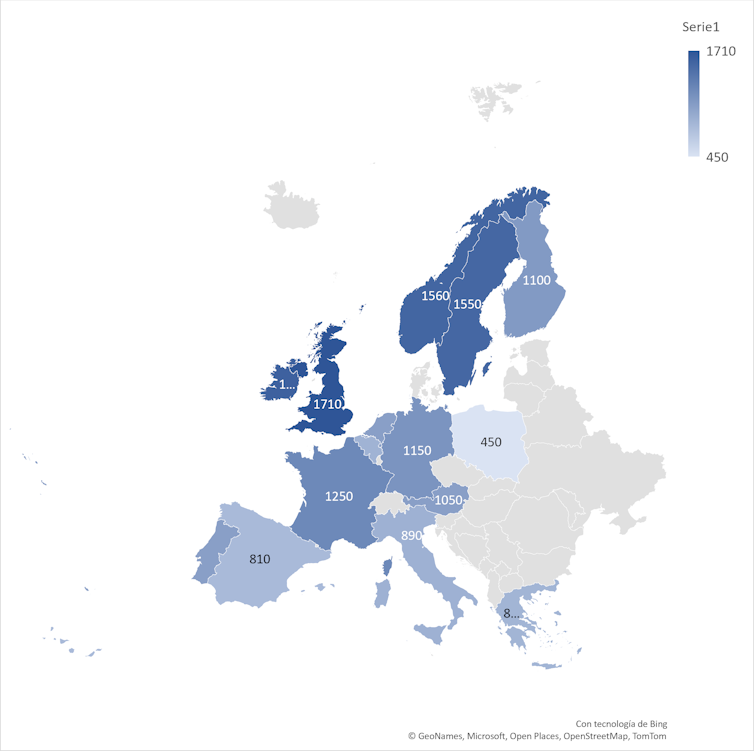He attractiveness of the capitals and large European cities is undeniable. For decades, people have come to them to work in the industrycreate companies and search living place or one better life quality.
Although central and affluent neighborhoods of the big European cities they have always been expensiveareas once populated by working-class households have gentrified, becoming home to high-income professionals and driving out residents who cannot afford rising rents.
In some cities, this is compounded by the fact that residential properties are dedicated to tourist rentalsas well as for the growing number of digital nomads: people who move and they work remotelyand who usually perceive a much higher salary to the local average.
As a result, many cities have become unlivable for those who grew up in them. A clear example is Portugal: he The country’s minimum monthly wage is 820 eurosbut a 25 m² studio in Lisbon can easily cost between 700 and 800 euros a month, and prices are expected to rise further this year.
The situation is plays throughout Europe. In almost all countries, even a small one-bedroom apartment is out of reach for low-wage earners: on average, rent one it would mean he 40% of your salary.
Foreign investment affects purchase and rental prices
From 2010 to the second quarter of 2023, the EU has witnessed a significant increase in property valuewith the house prices rising 46% and the rentals a twenty-one%.
A more detailed analysis reveals that in the second quarter of 2023, compared to the same period in 2010, the prices of the living place rent increases exceeded in 20 of the 27 EU Member States. In all EU countries, as well as in the United Kingdom and Norway, purchasing prices have risen since 2013 at rates well above inflation or wage increases.
The foreign investment plays a huge role in purchase prices. International investors –mostly from the United States and Asia– consider the European real estate as a safe and profitable investment, especially in politically stable countries with solid economies. This external demand puts pressure on the supply of housing, which drives up prices.
The rental markets are more regulatedwith measures such as temporary or permanent limitation on rents in some areas, making them less vulnerable to the whims of foreign investment. Therefore, the rentals media have increased more slowlycorresponding approximately to the inflation accumulated during the same period.
However, a broad continental average hides the vertiginous rise of prices of rents in some areas. In the Spanish city of ValenciaFor example, he rent It has been shot 19.4% only in the last yearand other cities like Malaga and Barcelona record increases greater than 10% in the same period.
Italy, France and above all, Ireland They have also seen prices rise to unsustainable levels in recent years.
It is worth taking into account that purchase prices will end up causing an increase in average rentssince the investors What do they seek profitability in more expensive homes pass the cost on to the tenants. Many European countries have laws that prohibit rent increases during certain periods or under certain conditions, but these can only be slow down the processand are often circumvented by aggressive eviction tactics.
“Tourism” and other factors that affect housing
A major obstacle in addressing the housing crisis is that the factors that influence demographic and economic changes vary a lot between the different regions and citiesas well as between the different generations and income levels. This makes it difficult for the EU legislationor even the national one, point out the problems and offer definitive solutions.
In SpainFor example, the tourism industry has a significant impact on prices of the home. At the end of 2023, the average house price in 64 tourist cities It was from 2,943 euros/m²in front of the 1,689 euros/m² for non-tourist areas. Between the fourth quarter of 2014 and the fourth quarter of 2023, housing prices in Spanish tourist cities increased by 61%while the increase in other areas was 38%.
However, the housing crisis in Europe cannot be blamed solely on tourism: in some areas, the problem stems from the simple lack of new housings. In Dublinyoung professionals fight to find housing due to rising prices and a shortage of affordable options.
In fact, Many blame house prices for Ireland’s current ‘brain drain’: an exodus of young educated professionals who leave the country in search of better opportunities.
With regards to the Purchase priceshe increase in financing costs, such as mortgage rates and deposits, represents another serious challenge. Although they are ultimately due to central banks’ actions to mitigate rising inflation, they have a huge impact on housing affordability.
My research has predicted that he increase in inheritances will cause a long-term decline in mortgage signing between Generation Zbut this is of little comfort to those currently facing an uphill battle to sign a mortgage, let alone pay it.
Do we know when (or if) it might end?
Unfortunately, as long as the appeal of European capitals remains strongis upward trend unlikely to reverse of the value of the home.
The magnetic attraction of metropolitan areas not only affects housing prices in the cities themselves, but also in the regions where they are located, thus widening the economic gap with less dynamic areas. Therefore, rising real estate prices may lead to a unequal distribution of wealth in the long termwhich will negatively affect employment and trade in regions that lack a large urban center.
In big cities like Paris, London, Madrid and Brusselsas well as in countless medium sized citieshe wage stagnation It is driving long-time residents away from city centers, who in turn push other residents even further away from downtown. This change disproportionately affects young households – particularly first-time buyers, who find the market increasingly out of reach – and families struggling to find homes of the right size for their needs.
The change that is taking place in the real estate markets is drastically altering the socioeconomic fabric of European citiesand it doesn’t seem like it’s going to slow down.
Geoffrey Ditta, Geoffrey Ditta Ph.D. Professor of Economics and International Business. Director of the Master’s Degree in Business Internationalization. Faculty of Economics and Business, Nebrija University.
This article was originally published in The Conversation. read the original.
![]()







![[Img #74683]](https://thelatestnews.world/wp-content/uploads/2024/12/The-main-mistakes-to-avoid-when-betting-on-electronic-sports-150x150.jpg)







Add Comment